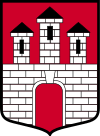Przytyk
| Przytyk | ||
|---|---|---|
| Village | ||
| ||
 Przytyk | ||
| Coordinates: 51°28′N 20°54′E / 51.467°N 20.900°ECoordinates: 51°28′N 20°54′E / 51.467°N 20.900°E | ||
| Country |
| |
| Voivodeship | Masovian | |
| County | Radom County | |
| Gmina | Przytyk | |
| Population | 990 | |
| Website | http://www.przytyk.pl/ | |
Przytyk [ˈpʂɨtɨk] is a village in Radom County, Masovian Voivodeship, in east-central Poland, founded in the year 1333.[1] It is the seat of the gmina (administrative district) called Gmina Przytyk.[2] It lies in historic Lesser Poland, approximately 20 kilometres (12 mi) west of Radom and 84 km (52 mi) south of Warsaw. In 2006 the village had a population of 990. For centuries Przytyk belonged to Sandomierz Voivodeship, and used to be a town from 1333 to 1869.
In the late Middle Ages, the area of Przytyk belonged to the Podlodowski family (Janina coat of arms), whose seat was located at a village of Zameczek (also called Ostrow). The town of Przytyk was founded in 1333 by Piotr Podlodowski (Piotr z Podlodowa). In 1488, due to efforts of Jan Podlodowski, the castellan of Zarnowiec, King Kazimierz Jagiellonczyk granted to Przytyk a privilege to make two fairs a year, and markets on Mondays. The tradition of Monday markets remains until now. In 1570 a wedding of one of the most famous Polish poets, Jan Kochanowski, took place at Przytyk’s church. His wife was Dorota Podlodowska of Przytyk, and as a result of the marriage, the town became the property of the Kochanowski family. Przytyk remained in their hands until 1835, when the family lost it after the November Uprising. Like almost all Lesser Poland’s towns, Przytyk was completely destroyed in the Swedish invasion of Poland (1655 - 1660).
Until the Partitions of Poland, Przytyk belonged to Lesser Poland’s Sandomierz Voivodeship. The town took advantage of a convenient location, at the intersection of two important merchant routes - the so-called Royal Trail (Warsaw - Kraków), and the Greater Poland Trail (Lublin - Poznań). In 1834, the government of the Russian-controlled Congress Poland opened a new road from Warsaw towards Kraków (via Radom), which bypassed Przytyk. In 1869, as a punishment for the January Uprising, Przytyk lost its town charter. In 1895, the village was completely destroyed by a fire, leaving 4,000 inhabitants homeless. The one building not destroyed was a church.[3]
In the Second Polish Republic, Przytyk belonged to Kielce Voivodeship, and was the scene of an anti-semitic pogrom on March 7-9, 1936 [4] Prior to the Holocaust, some 80% of population of the village was Jewish. Most perished in the Holocaust. In March 1941, Przytyk and the surrounding area was turned into a Luftwaffe training facility. All Polish residents were ordered to leave the village, and all buildings were destroyed by the Germans, except for the church. The destruction of the church was ordered on September 8, 1944, but this plan was halted due to lack of time. As a result, there are no historic buildings in Przytyk.
External links
- Jewish Community in Przytyk on Virtual Shtetl
References
- ↑ "Serwis Informacyjny Urzędu Gminy w Przytyku - www.przytyk.pl" (html (polish)). Urząd Gminy Przytyk. Retrieved 26 July 2009.
- ↑ "Central Statistical Office (GUS) – TERYT (National Register of Territorial Land Apportionment Journal)" (in Polish). 2008-06-01.
- ↑ "Pzrzytyk Destroyed by Fire" (PDF). The New York Times. 17 August 1895.
- ↑ Gilbert, Sir Martin (1986). The Holocaust: A History of the Jews of Europe During the Second World War. Henry Holt and Company. p. 51. ISBN 978-0-03-062416-2.
